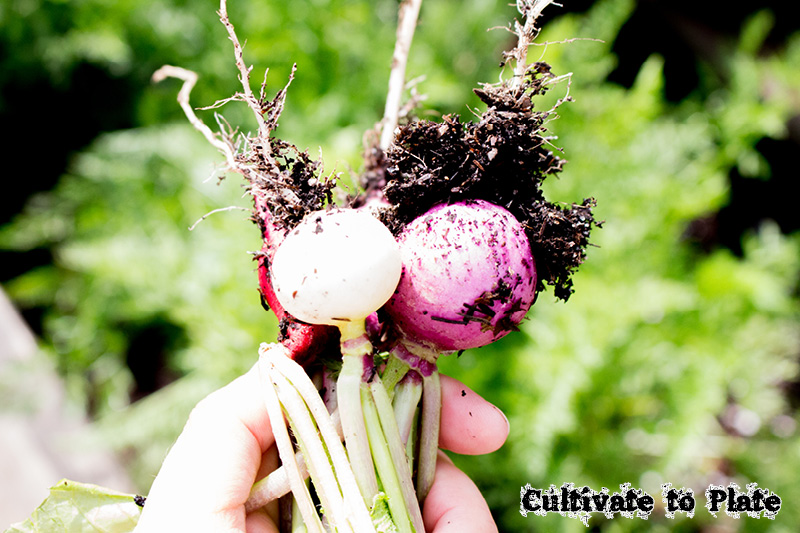Radishes: Growing, Harvesting, and Cooking with this Easy Vegetable
If you are looking for about the easiest and most consistent thing to grow in the garden, then look to radishes. They are practically foolproof, and they come in a wide variety of shapes, sizes, and even colors. They can be planted in both containers and in the ground, if there is an indoor planter in the kitchen, radishes can be successfully planted year round in the house.
Radish Varieties
Most people envision all radishes being the red-on-the-outside and white-on-the-inside variety that all supermarkets carry. This is unfortunate because the simple radish can be found in all colors, shapes and sizes, from long carrot looking things to squat, cylindrical shaped ones. Radishes are divided into three main categories by when they are planted and harvested: spring, summer, and fall/winter. The spring varieties are begun in the cooler spring temperatures and mature much faster. These are lighter in flavor but tend to be pithy in texture when grown in hotter temperatures. Summer types withstand the heat much better than the spring ones, and have a mid-range growing time. The winter varieties have a longer growing period and are started in midsummer for late fall harvest. These types are larger and can be stored for longer periods of time, and have a much hotter flavor.
Spring Varieties
- Easter Egg – Pretty multiple color radishes in shades of pink, purple and lavender, red, and white. Nice oval shape with great flavor. 25 days to maturity.
- Early Scarlet Globe – Round shape with red skin and a white interior. Very mild in flavor.
- Snow Belle – White radish with a round shape. 30 days to maturity.
Summer Varieties
- Icicle Radish – White radishes with a long, tapered shape. The are mild when picked young but intensify in flavor when picked later. These can be planted during the spring or summer. 25 days to maturity.
- Cherriette – Smaller, classic shaped and colored (red exterior, white interior). These are slow to develop pith making them a great choice for summer plantings.
Winter Varieties
- Black Winter Radish – Black skin with a white flesh, this radish has a peppery flavor. Good for root cellars. 50 days to maturity.
- Chinese White Radish (Daikon)– Large white radishes with a 7 to 8 inch long root (or longer with some varieties) and a spicy flavor. Good variety for cooking. 60 days to maturity.
- Watermelon Radish – This fun variety has a red interior with a skin that fades green to white. Excellent for winter salads due to its presentation. 50 days to maturity.
Growing Radishes
Spring varieties can be planted as soon as the soil is workable, and when planted in staggering plantings every 10 to 14 days, can be harvested all summer. The temperature affects the flavor and texture. The hotter the temperature the hotter the radish; the milder the temperature the milder the radish. The radishes grown in cooler weather will also be more tender, too.
Winter varieties withstand the heat much better than the spring varieties. These are planted mid-summer to late summer for a late fall harvest.
Sow both varieties about a half inch deep. Thin the spring varieties to about an inch between the radishes, and since the winter varieties are much larger, allow for 2 to 4 inches between the plants for growth. Keep the soil evenly moist throughout the growing with regular watering. Uneven watering times can lead to leggy roots.
Harvesting Radishes
Harvest the spring radishes as soon as they can be picked, when they are just big enough for your eating purpose. If left longer in the ground, they tend to be spongy in texture, and have a much hotter flavor profile. If they are kept too long, they become very tough. The winter varieties may be left in the ground longer and still be usable.
Radish Growing Troubleshooting
If you pull up radishes that are less then perfect, here are some common radish troubleshooting gardening solutions.
- Cracked or split radishes – Radishes were left too long in the ground, or they were grown during very uneven watering.
- No root development – Try sowing the seeds less dense, and thinning the radishes out properly whey they are sprouts.
- Very strong flavor – The radishes were left in the ground too long intensifying their flavor.
- Bolting plants – Radishes that sprout flowers or seed stalks are usually from planting the radish variety at the wrong time or leaving in the ground too long. Plant spring radish seeds in the early spring and harvest promptly, and plant winter seeds in the late summer to prevent a longer growing season for the fall harvest.
Cooking with Radishes
Radishes are commonly eaten fresh, but are also a great choice for sauteing and roasting. They keep their bite and spiciness making them ideal for all kinds of salad and vegetable side dish applications. Here are two recipes for radishes, one raw and one cooked.
- 4 large radishes washed and trimmed
- 1 medium carrot trimmed
- 1 celery stalk trimmed
- Six to eight chives cut into one-inch pieces
- salt and freshly ground black pepper
- 1/4 cup sweet rice vinegar
- 1/4 cup olive oil
- 1/2 teaspoon celery seed
- 6 romaine lettuce leaves
-
Using a mandolin or box grater, shred the radishes and carrots into a mixing bowl.
-
Cut the celery stalks into matchstick-size julienne sticks. Mix the radishes, carrots, and celery in a bowl mix.
-
In a small bowl whisk together olive oil, sweet rice vinegar, celery seed, and salt and pepper until combined. Pour over the vegetables and toss to coat.
-
Serve on a bed of romaine lettuce.

- 10 radishes trimmed
- 2 yellow beets quartered
- 2 teaspoons stoneground mustard
- 2 teaspoons olive oil
- 2 tablespoons chopped fresh chives
- 1/4 teaspoon salt
-
Preheat oven to 425 degrees F.
-
Place the prepared radishes and beets in a mixing bowl. In a small bowl, mix the mustard and the olive oil, and toss with the vegetables. Sprinkle the chives over the top, add the salt, and toss well to coat.
-
Arrange them in an even layer on a sheet pan, and bake for 30 minutes until fork tender.
-
Serve hot.

You must be logged in to post a comment.